Mytilus galloprovincialis
È un mollusco bivalve, di circa 5-9 cm, che si nutre di plancton e particellato organico catturati per filtrazione. E’ molto diffuso in tutto il Mediterraneo, ma essendo una specie ampiamente allevata la sua distribuzione è assai più ampia, infatti ha colonizzato ampie zone costiere dell’intero pianeta: è presente lungo le coste atlantiche della Penisola Iberica e del Sud Africa, della Cina, dell’Australia e Nuova Zelanda, nonché della costa occidentale degli Stati Uniti. In natura, forma delle colonie fittissime lungo il litorale nella zona intertidale (ovvero la fascia di battigia che rimane scoperta con la bassa marea). è in grado di sopportare sia grandi variazioni di salinità sia periodi di emersione più o meno prolungati. Quest’ultima capacità è resa possibile dall’acqua che l’animale è in grado di trattenere all’interno della sua conchiglia chiusa ermeticamente. Si presenta infatti composta da due valve simmetriche che formano una conchiglia allungata, appuntita da un lato, larga dal lato opposto e di colore blu, nero o marrone. Secerne un filamento assai resistente, il bisso, che indurisce a contatto con l’acqua e gli permette di fissarsi sulle rocce o su ogni altro tipo di supporto duro. I sessi sono separati e distinguibili quando la conchiglia viene aperta: all’interno i maschi sono colore giallo-ocra e le femmine rosse. La fecondazione è esterna, ovvero la riproduzione avviene emettendo sperma e uova nell’acqua. Si tratta di una specie assai importante per l’allevamento.

